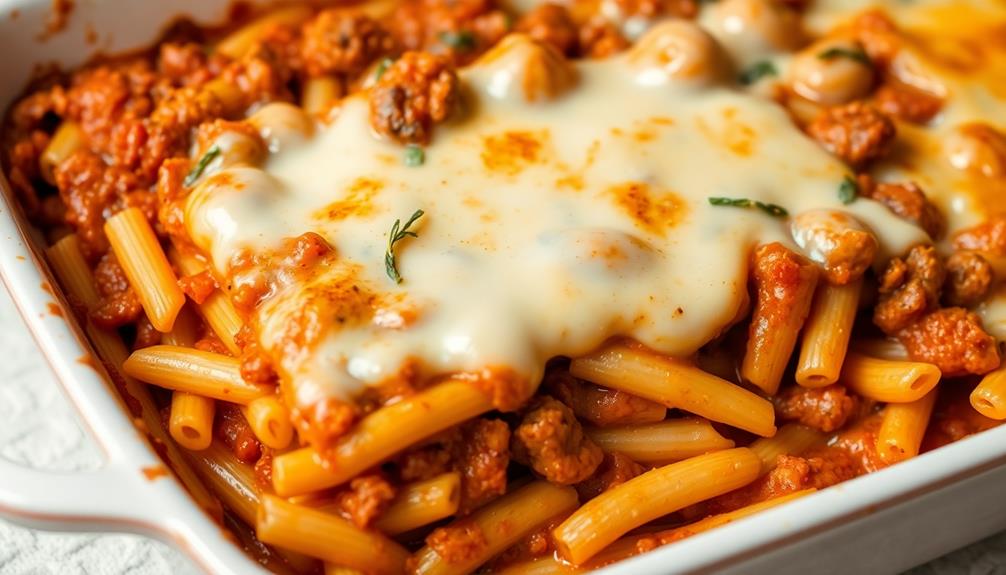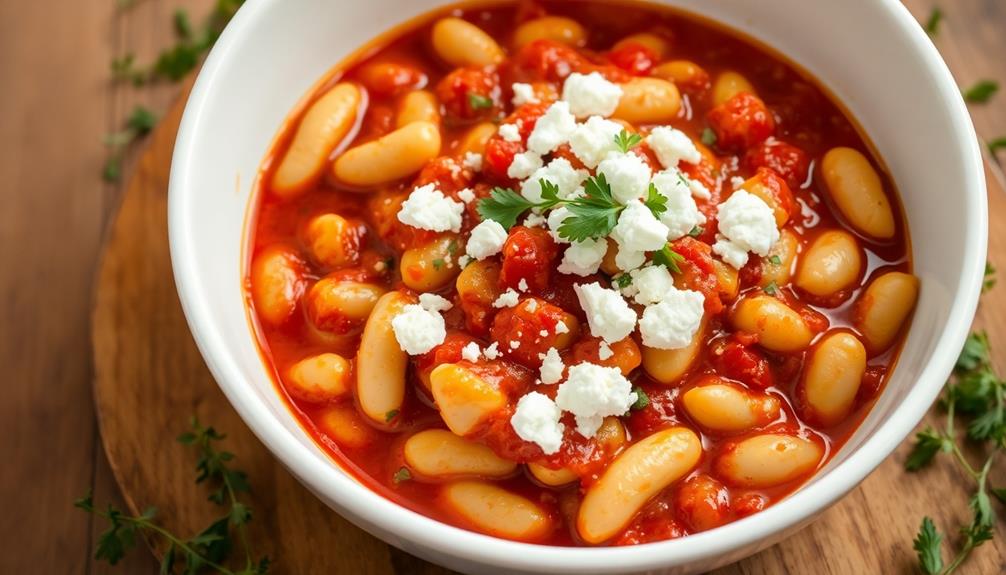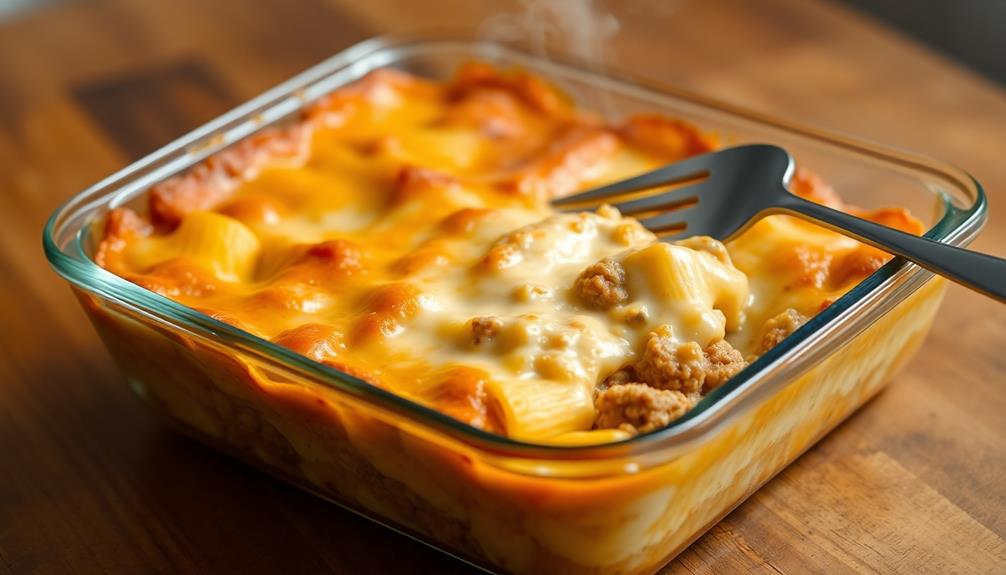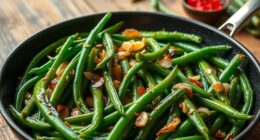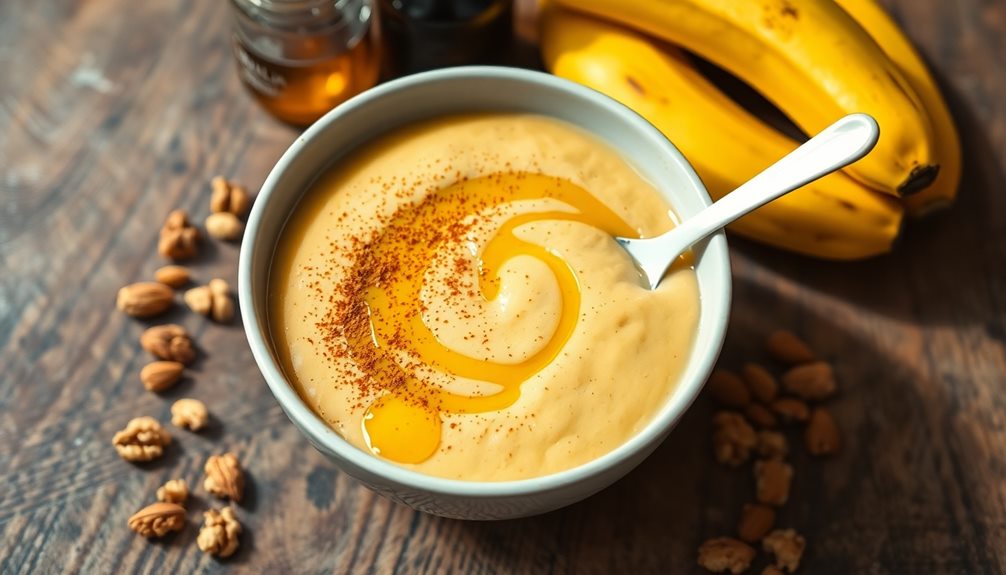Kleftiko, a beloved Greek dish, is a mouth-watering slow-cooked lamb that transports you to the rugged countryside, where resilient rebels known as "klefts" once concealed their cooking in underground pits during the Ottoman occupation. This rustic delicacy features tender chunks of lamb, marinated in a blend of aromatic herbs and spices, then slowly baked to perfection. The result is a deeply flavorful and comforting meal, often served with roasted potatoes or a fresh salad, and accompanied by tangy lemon wedges. Kleftiko embodies the spirit of Greek hospitality, inviting you to gather with loved ones and savor the rich history and flavors of this timeless dish. Intrigued to learn more?
Key Takeaways
- Kleftiko is a traditional Greek dish featuring slowly cooked lamb that is marinated with herbs and spices.
- It originated during the Ottoman occupation, with rebels known as "klefts" cooking lamb in underground pits to avoid detection.
- The dish is cooked at a low temperature for hours, resulting in a deeply flavorful and comforting meal.
- Kleftiko represents a communal dining experience, often enjoyed during family gatherings and celebrations.
- The dish is typically served with roasted potatoes or a fresh salad, and fresh lemon wedges complement the rich flavors of the lamb.
History
Kleftiko, the slow-cooked lamb dish, has a rich history rooted in the Greek countryside. During the Ottoman occupation of Greece, rebels known as "klefts" would hide in the mountains to avoid capture.
These klefts would cook their lamb in underground pits, slowly simmering the meat to perfection while concealing the smoke and aromas from their pursuers. This ingenious method, combining the flavors of the lamb, vegetables, and herbs, became the foundation of the beloved kleftiko dish.
Over time, this traditional cooking technique spread throughout Greece, each region adding its own unique touches. In the Mani peninsula, the lamb is often seasoned with garlic, lemon, and oregano, while in the Cycladic islands, the meat may be wrapped in grape leaves.
Today, kleftiko remains a beloved part of Greek cuisine, a testament to the resilience and ingenuity of the klefts who first developed this mouthwatering slow-cooked delight.
Recipe
Kleftiko is a traditional Greek dish that showcases the incredible flavor of slowly cooked lamb. The meat is marinated in a blend of fragrant herbs and spices, then wrapped in parchment paper and cooked at a low temperature for hours, allowing the flavors to meld and the lamb to become incredibly tender and juicy.
The slow cooking process is essential to the success of this dish, as it transforms the tough cuts of lamb into a melt-in-your-mouth delight. The result is a deeply flavorful and comforting meal that's perfect for sharing with family and friends.
Ingredients:
- 3 lbs lamb shoulder, cut into large chunks
- 1 onion, sliced
- 6 cloves garlic, minced
- 2 tbsp dried oregano
- 1 tsp dried thyme
- 1 tsp ground cinnamon
- 1 tsp ground allspice
- 1/4 cup olive oil
- Salt and pepper to taste
- 1 cup dry white wine (optional)
Cooking Instructions:
Preheat the oven to 275°F (135°C). In a large bowl, combine the lamb, onion, garlic, oregano, thyme, cinnamon, allspice, olive oil, and season with salt and pepper. Mix well to ensure the lamb is evenly coated.
Place the seasoned lamb and vegetables in the center of a large piece of parchment paper. Fold the parchment paper over the lamb to create a sealed packet, then place the packet on a baking sheet. Bake for 3-4 hours, or until the lamb is very tender and falling apart.
Tips:
For even more flavor, you can add a cup of dry white wine to the parchment packet before sealing it. The wine will create a delicious braising liquid that will infuse the lamb with additional depth of flavor.
Additionally, you can serve the kleftiko with roasted potatoes or a fresh salad for a complete and satisfying meal.
Cooking Steps
Let's start by combining all the ingredients in a roasting pan.
Cover the pan tightly with foil, then pop it in the oven at 325°F for 3 hours.
Once that time's up, remove the foil, baste the lamb, and you're ready to serve with some tangy lemon wedges on the side.
Step 1. Combine Ingredients in Roasting Pan
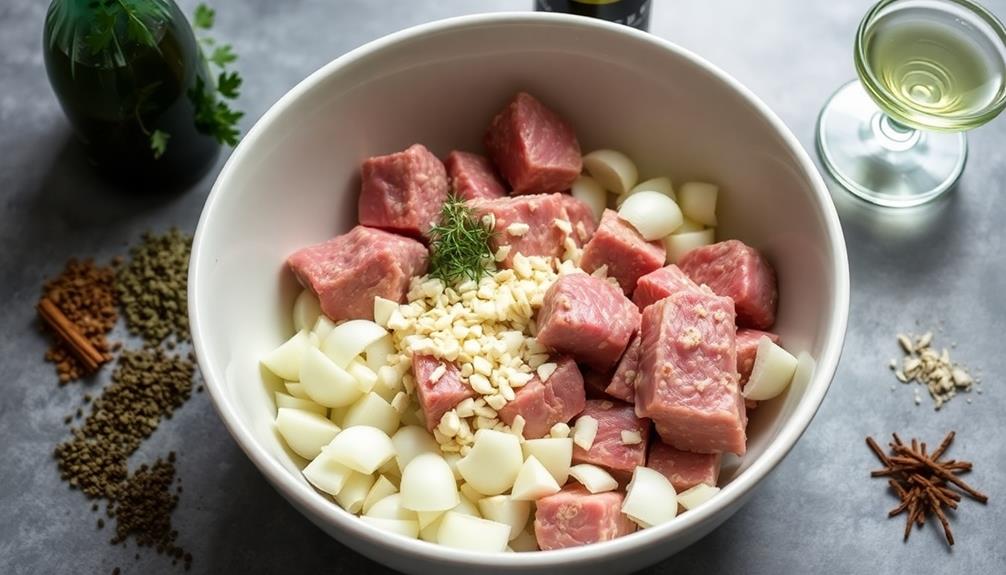
Next, gather all the prepared ingredients and combine them in a large roasting pan. Layer the lamb chunks in the center, then surround them with the wedged potatoes, onions, garlic, and oregano. Drizzle the olive oil over everything, ensuring all the ingredients are well coated.
Give the pan a gentle shake to help the flavors mingle.
Now, pour in the white wine and lemon juice. The liquid should come about halfway up the sides of the meat and vegetables. Crumble the bay leaves over the top, distributing them evenly. Finally, season generously with salt and pepper. You want to create a flavorful base for the lamb to slowly braise in as it cooks.
Once everything is assembled, cover the roasting pan tightly with aluminum foil. This will trap the steam and juices, resulting in incredibly tender, fall-off-the-bone lamb.
You're now ready to slide the pan into the oven and let the magic of slow cooking commence.
Step 2. Cover Pan With Foil
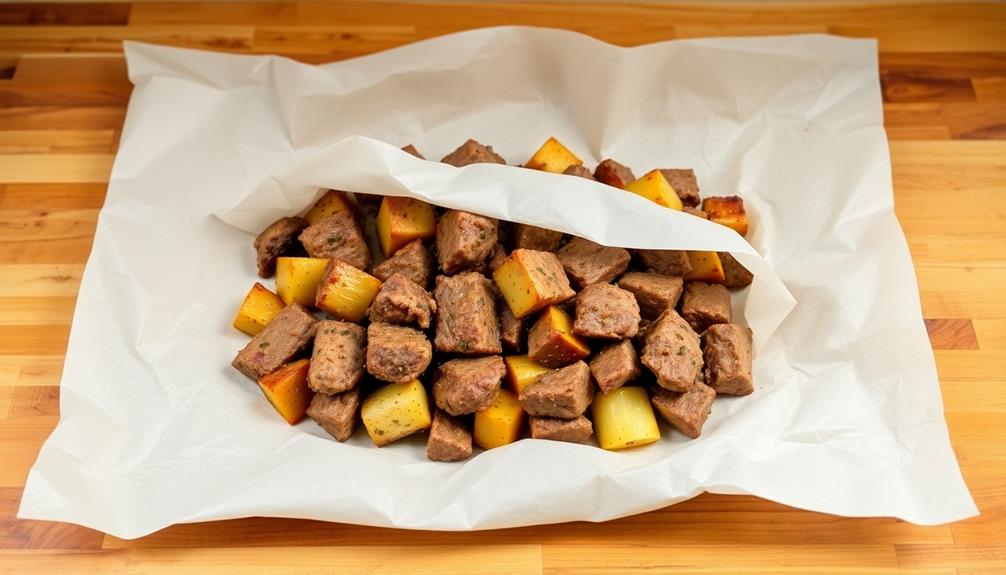
With the ingredients assembled in the roasting pan, you'll want to cover it tightly with aluminum foil. This step is crucial for creating the signature slow-cooked flavor and tender texture of the lamb.
The foil will trap the steam and juices, allowing the meat to braise gently in its own flavors. Make sure the foil is sealed securely around the edges of the pan to prevent any steam from escaping.
The foil will also help to keep the lamb moist and prevent it from drying out during the long cooking time. As the lamb cooks, the juices will create a flavorful braising liquid that will baste the meat and infuse it with amazing aromas.
When it's time to serve, simply remove the foil and you'll be greeted by a succulent, fall-off-the-bone masterpiece. The foil-wrapped cooking method is a key component of the traditional kleftiko recipe, so don't skip this important step.
Step 3. Bake at 325°F for 3 Hours
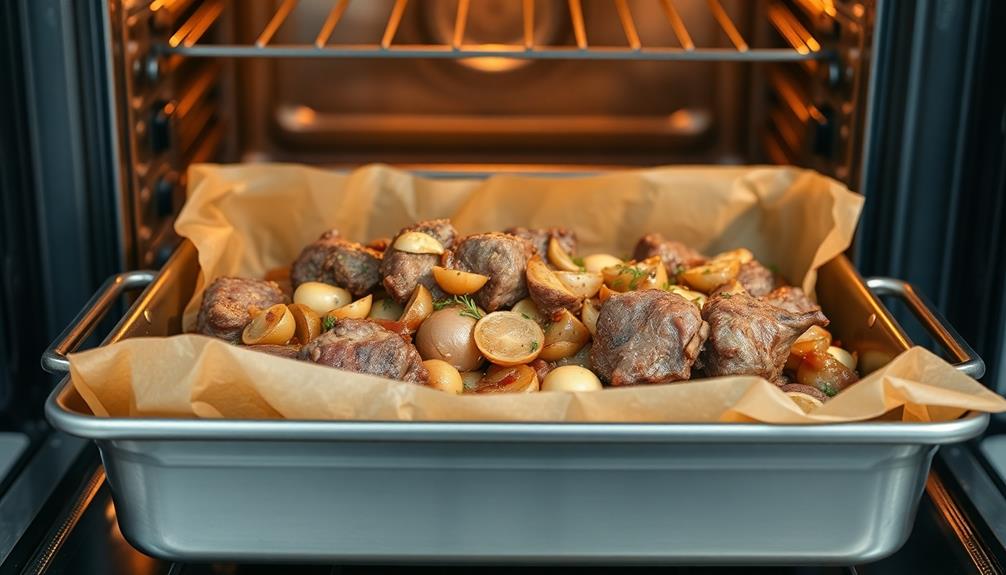
With the pan tightly sealed with foil, you'll want to place it in a preheated oven set to 325°F.
For the next three hours, this low and slow cooking method will work its magic, transforming the lamb into a meltingly tender delight.
As the meat cooks, the aromatic herbs and spices will infuse the entire dish, filling your kitchen with the most tantalizing aroma.
Every now and then, you might want to peek through the oven window, just to catch a glimpse of the lamb's progress.
But resist the urge to open the oven too often, as that will disrupt the heat and slow down the cooking process.
Trust the process, and before you know it, you'll have a succulent, fall-off-the-bone lamb dish that's well worth the wait.
The anticipation will only make the final result taste that much more heavenly.
Step 4. Remove Foil, Baste Lamb

After three hours of patient waiting, it's now time to take off the foil and baste the lamb.
Carefully remove the foil from the baking dish, being mindful of the hot steam escaping. Grab a basting brush and dip it into the flavorful juices that have accumulated in the bottom of the dish.
Gently brush the juices all over the surface of the lamb, ensuring every inch is coated. The aroma of the slowly cooked meat will fill your kitchen, making your mouth water in anticipation.
Take a moment to admire the golden-brown crust that has formed on the outside of the lamb. Use a meat thermometer to check the internal temperature, aiming for an internal temperature of 165°F for medium doneness.
If the lamb needs a bit more time, re-cover with foil and return to the oven until it reaches your desired level of tenderness.
Get ready to savor the rich, succulent flavors of this slow-cooked masterpiece.
Step 5. Serve With Lemon Wedges
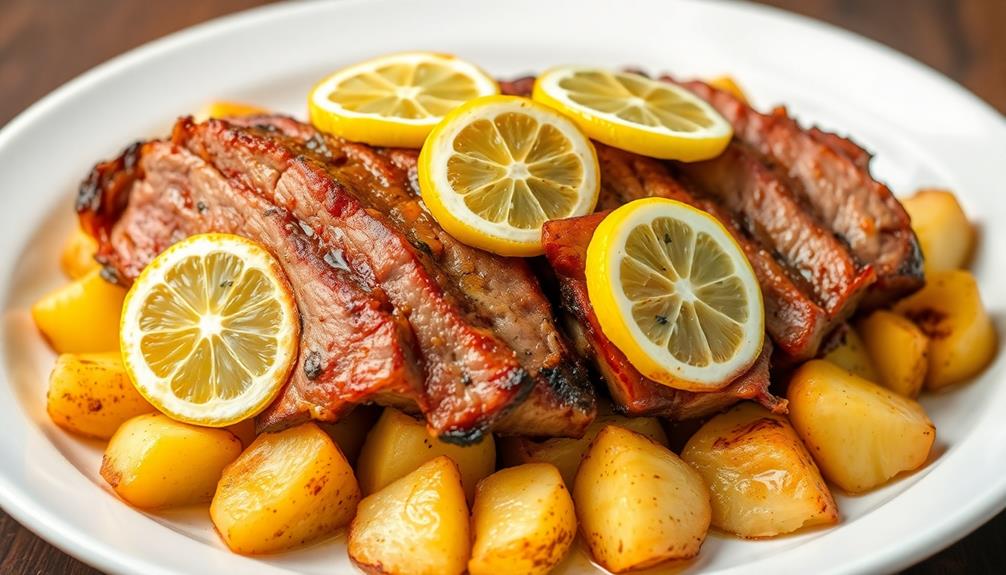
Squeeze fresh lemon wedges over the succulent lamb just before serving. The bright, tangy citrus flavor perfectly complements the rich, tender meat.
Invite your guests to pick up a wedge and squeeze it directly over their portion, allowing the zesty juice to drizzle down and mingle with the savory juices of the lamb. The contrast of the bright lemon and the melt-in-your-mouth texture of the meat is utterly irresistible.
Serve the kleftiko with the lemon wedges on the side, encouraging everyone to personalize their dish to their liking. The lemon adds a refreshing zing that cuts through the richness of the slow-cooked lamb, cleansing the palate and preparing you for the next flavorful bite. Don’t be afraid to experiment with different seasoning combinations, such as adding a sprinkle of oregano or a drizzle of olive oil to enhance the flavors. For those looking to expand their Greek culinary repertoire, consider trying your hand at a traditional kokoretsi recipe for a truly authentic dining experience. The combination of organ meats and offal, skewered and grilled to perfection, offers a unique and delicious addition to any Greek feast.
As your guests squeeze the lemon and watch the juice dance over the meat, their eyes will light up with delight at the bright, vibrant flavors. The simple addition of this citrus twist transforms the kleftiko into a truly exceptional dining experience.
Final Thoughts
Ultimately, the beauty of Kleftiko lies in its simplicity. This dish, with its slow-cooked lamb, fragrant herbs, and tender vegetables, is a true testament to the power of letting time and patience work their magic.
As you savor the first bite, you'll be transported to the sun-drenched islands of Greece, where the Kleftiko was born.
The real joy of this recipe, however, lies in the shared experience. Gather your loved ones around the table, pour a glass of robust red wine, and let the flavors of Kleftiko bring you closer together.
Dig in with your hands, tearing off succulent pieces of lamb, and don't forget to dip your bread in the flavorful juices.
The beauty of Kleftiko is that it's not just a meal – it's a celebration of life, family, and the simple pleasures that make us truly alive.
Frequently Asked Questions
What Is the Best Cut of Lamb for Kleftiko?
When choosing the best cut of lamb for your dish, you'll want to opt for a shoulder or leg cut. These tougher, well-marbled parts are perfect for the slow-cooking method, ensuring a tender, flavorful result.
Can Kleftiko Be Made With Other Types of Meat?
You can absolutely make a slow-cooked dish using other types of meat besides lamb. Pork, beef, or even chicken can work well in a recipe similar to kleftiko, providing you adjust cooking times accordingly.
How Long Does Kleftiko Need to Marinate Before Cooking?
To get the best flavor, you'll want to marinate the meat for at least 4 hours, though overnight is better. This allows the seasonings to really penetrate and tenderize the meat before cooking.
Can Kleftiko Be Cooked in a Conventional Oven?
Yes, you can cook this dish in a conventional oven. While the traditional method uses a wood-fired oven, you can achieve similar results by slowly roasting the meat in a regular oven for several hours.
Is Kleftiko Traditionally Served With Any Specific Side Dishes?
Traditionally, kleftiko is often served with specific side dishes that complement the slow-cooked lamb's rich and tender flavors. You might find it paired with roasted potatoes, tzatziki, and a fresh Greek salad to balance the meal.



